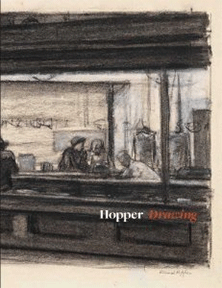By Svetlana Alpers
Edward Hopper (1882-1967) is a much-loved American painter known for his paintings of his own country. His painting is iconic not only in America, but also abroad. The large Hopper exhibition at the Grand Palais in Paris in the fall of 2012 was crowded with viewers and cheered by the critics. His distinctive images stick in the mind: isolate people sitting at a counter in a New York night (Nighthawks) or a row of low buildings along an avenue in the West Village near where Hopper lived (Early Sunday Morning). The colors of the flatly applied paint are special—the particular green and the reds of those two paintings.
This large-format, well-illustrated book was published on the occasion of an exhibition of Hopper’s drawings at the Whitney museum. Hopper drew a lot. After his death his widow gave 2,500 drawings to the museum. In sheer number the drawings overwhelm the few, hard-worked paintings. Motifs mattered to Hopper. We remember Hopper paintings for a street, a restaurant, a gothic house, and finally, only a wall and a window. This book has essays on paintings of specific motifs and the drawings connected to each. The drawings and in addition the photographs of his sites reproduced in the book let us consider him in the making of his art.
The drawings of an artist can show things that the paintings avoid, evade, or perhaps over-ride. Their beauty can lie in a skillful display of things otherwise not seen or, as it were, not said. That is not true here. Hopper wrote that he did not care so much for his drawings. But the drawings were necessary for Hopper to make in order to be able to make the paintings he aspired to. It is a curious case. Though surely the museum aimed to show off its holdings, the book and exhibition help us to see why Hopper said about them what he did. His drawings are not likeable.
Hopper began by painting from life in the first decade of the 20th century when he lived on several occasions in Paris. But he put Europe behind him: both the brushy kind of painting that was so European and also the practice of painting outdoors. He continued to draw from life (“from the fact” in his flat and pungent words). The drawings show him laboring to get the shape of a hand, the proportions of a room, or the space of a painting to come.
Cézanne despaired of being able to make paintings that equaled nature. It has been argued that he left paintings unfinished out of that despair. Hopper’s despair was about making paintings equal to what was in the mind. It is an idealist position for an artist interested in the real.
The exceptional drawings, the ones that he made in the 1920s using the fabricated black chalk that he preferred and handled with such verve, are pictures in themselves. The places and particularly the figures in them are related to Hopper’s etchings and to the magazine illustrations in which he discovered his thematic way. The etchings are real rather than ideal. It is the marks, not the mind, that makes them such impressive works of art.
So what does one make of Hopper’s art as a whole, that is if one goes beyond thinking of him as the painter of iconic images of America? The book brings us to that question without providing an answer.
Svetlana Alpers, an artist, critic and renowned art historian, is professor emerita of the history of art at the University of California, Berkeley and a visiting scholar in the Department of Fine Arts at New York University.




